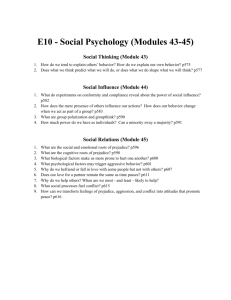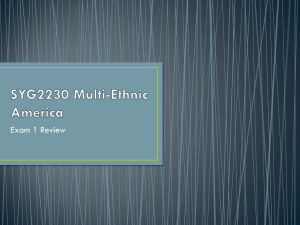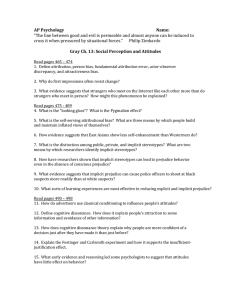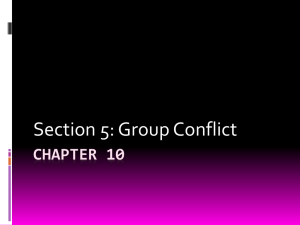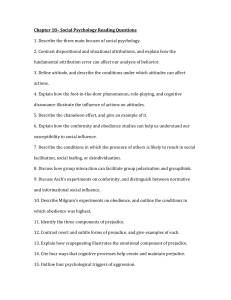The Power of the Situation
advertisement
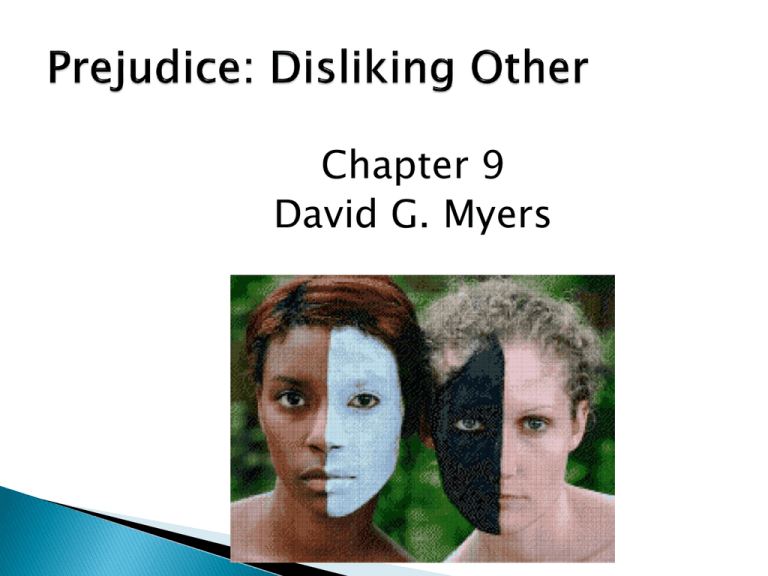
Chapter 9 David G. Myers Nature and Power of Prejudice Social Sources of Prejudice Motivational Sources of Prejudice Cognitive Sources of Prejudice Consequences of Prejudice Reducing Prejudice Prejudice – a negative prejudgment of a group and its individual members ◦ Stereotype – beliefs about the personal attributes of a group of people Typically overgeneralized and inaccurate ◦ Discrimination – unjustifiable negative behavior towards a group or its members Racism Sexism Heterosexism Ageism Weight Bias Changing Prejudice – most American’s racial and gender attitudes have changed in the last 30 years ◦ 90% say people should be treated fairly w/out discrimination ◦ Only 14% say they are highly prejudiced ◦ http://www.huffingtonpost.com/2010/05/28/jon-stewart-takes-on-race_n_593527.html Publicly people may not admit to prejudice, but stats. show it still exists ◦ 53% of African-Americans feel excluded on college campuses ◦ 61% of people would not see a homosexual doctor ◦ Profiling - In NJ 35% of all stopped drivers are Black (15% of speeders) ◦ Interracial Acquaintances vs. Interracial Intimacy ◦ Race in America Gender Stereotypes – typically are stronger than racial stereotypes (Feminism?) ◦ Ambivalent Sexism – mix of hostile and benevolent attitudes Sexism is even more severe in other countries Dual Attitudes - automatic reactions (implicit) still occur regardless of one’s conscious (explicit) level of prejudice ◦ Automatic reactions are affected by stereotype activation (priming) "Every man has reminiscences which he would not tell to everyone but only his friends. He has other matters in his mind which he would not reveal even to his friends, but only to himself, and that in secret. But there are other things which a man is afraid to tell even to himself, and every decent man has a number of such things stored away in his mind.“ (Fyodor Dostoyevsky ) Modern Prejudice – subtle, even unconscious forms of discrimination, revealed through preferences and associations, and judgments ◦ Modern Sexism & Racism - discrimination that occurs when it’s able to hide behind other motives ◦ http://oregonstate.edu/dept/ncs/newsarch/2006/May06/name.html ◦ Prentice-Dunn “Shocking Study” Hart et al (2000). Impression Study Implicit Association Test (IAT) – measures conscious and unconscious associations ◦ Predicts hiring decisions, medical decisions, interpersonal interactions, biased judgments https://implicit.harvard.edu/implicit/ Round One ◦ Left Hand African American Name Right Hand Caucasian Name Round Two ◦ Left Hand Positive Adjective Right Hand Negative Adjective Round Three ◦ Left Hand African American name Negative Adjective Right Hand Caucasian name Positive Adjective Round Four ◦ Left Hand African American name Positive Adjective Right Hand Caucasian name Negative Adjective Social Inequalities – stereotypes are used to rationalize unequal status ◦ Social Dominance/Authoritarian Orientation – motivation to have your group be dominant over others Religion and Prejudice – religion is used an excuse for social injustice ◦ Religion does not cause prejudice Conformity - prejudice is often maintained by public apathy and inertia Institutional Supports – political leaders, organizations, and education reflect and reinforce attitudes ◦ Face-ism – male ads focus more on faces and females focus more on the body ◦ Comparing how Blacks and White women are portrayed in the top movies of 1996. ◦ White female movie characters shown using vulgar profanity: 17% ◦ Black female movie characters shown using vulgar profanity: 89% ◦ White female movie characters shown being physically violent: 11% ◦ Black female movie characters shown being physically violent: 56% ◦ Times more likely that a mug shot of the accused will appear in a local TV news report when the defendant is Black rather than White: 4X Frustration & Aggression Hypothesis –frustrations can lead to displaced aggressions ◦ Realistic Group Conflict Theory – prejudice arises when groups are competing for scarce resources Social Identity Theory – our self-esteem is influenced by our membership in groups Categorization – we simplify & organize our world by categorizing people into groups ◦ Rely on stereotypes when pressed for time, preoccupied, tired, emotionally aroused, and lacking experience ◦ Ingroup/Outgroup Bias – the tendency to view ingroup members more favorably that outgroup members ◦ Outgroup Homogeneity Bias – outgroup members are seen as more similar to one another Stereotypes can bias attention, interpretation and memory (Illusory Correlations) Distinct People – draw our attention and have exaggerated bad and good traits Stigma Consciousness - Distinctive individuals sometimes imagine attention when there is none Vivid Stimuli - extreme events are remembered better and can distort judgments (e.g. Black athletes, Muslim extremists, Homosexual criminals, etc.) Attributions - we commit the FAE when explaining outgroup members’ behaviors ◦ ◦ Group-Serving Bias – we are lenient with ingroup members and quick to condemn outgroups Just-World Phenomenon – false belief that the world is fair and people get what they deserve Self-fulfilling Prophecy – negative expectations and behaviors cause others to confirm stereotypes ◦ Stereotype Threat – self-confirming concern where one’s behavior will verify a negative stereotype Knowledge and Awareness Motivation to Avoid prejudice ◦ Internal vs. External Motivation Seeking out diverse experiences Monitoring and Controlling the prejudice habit
